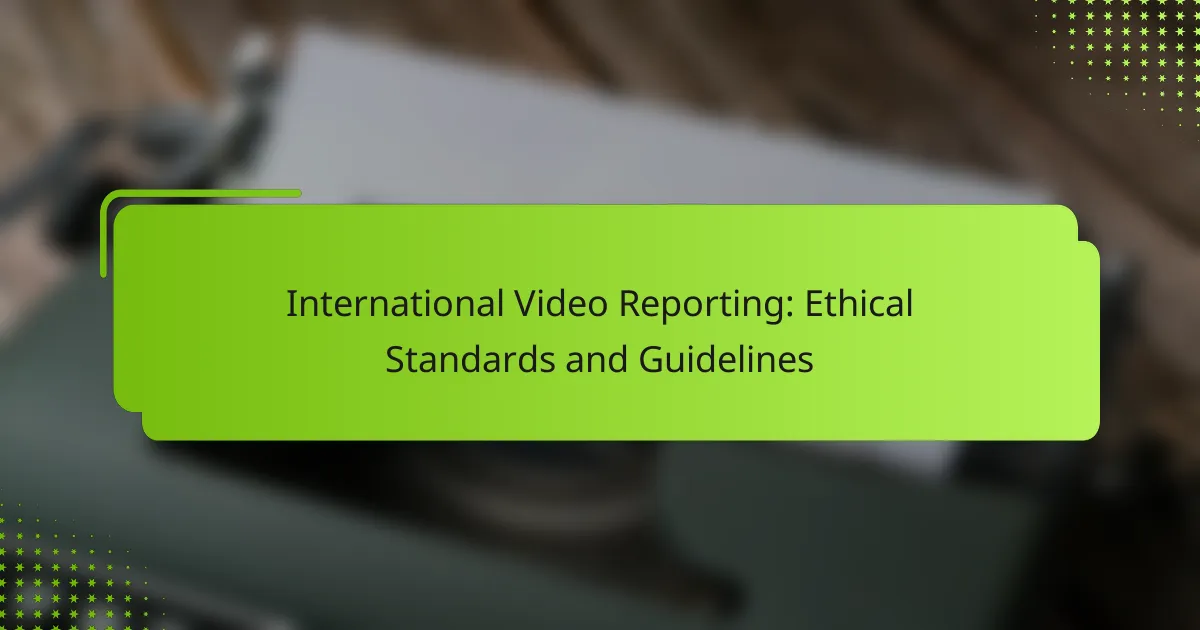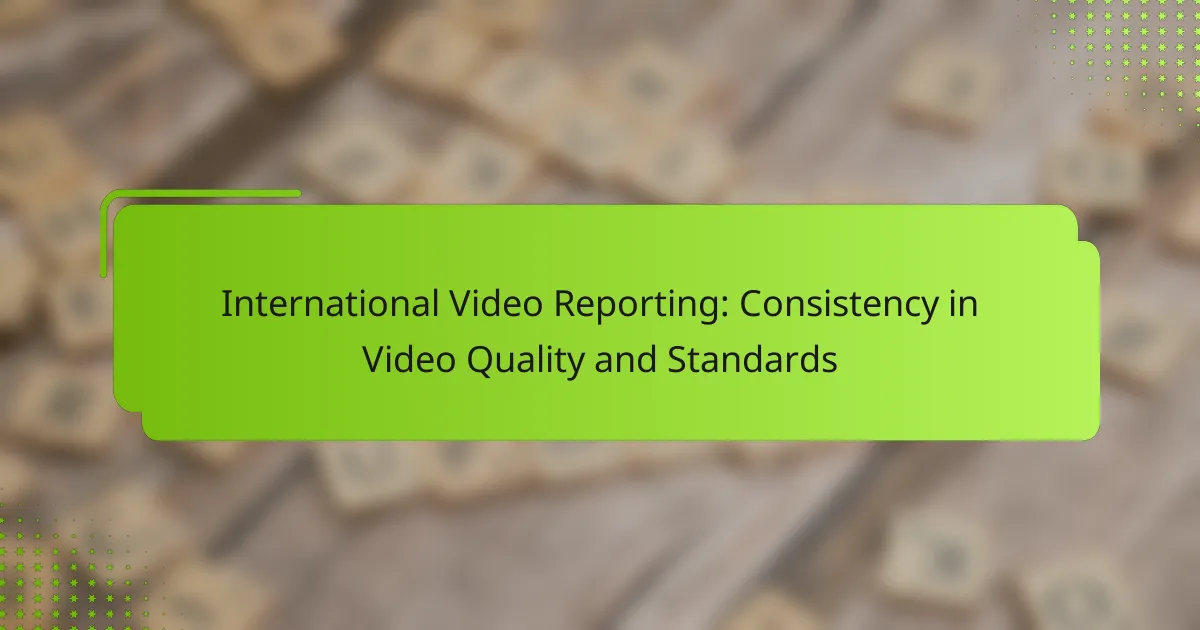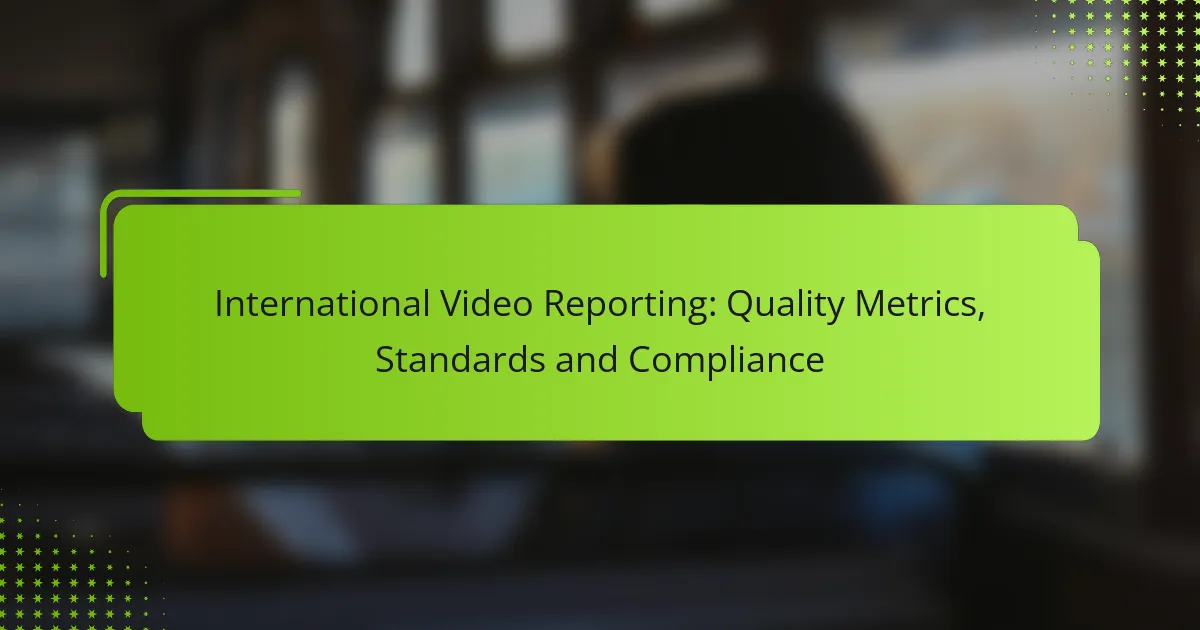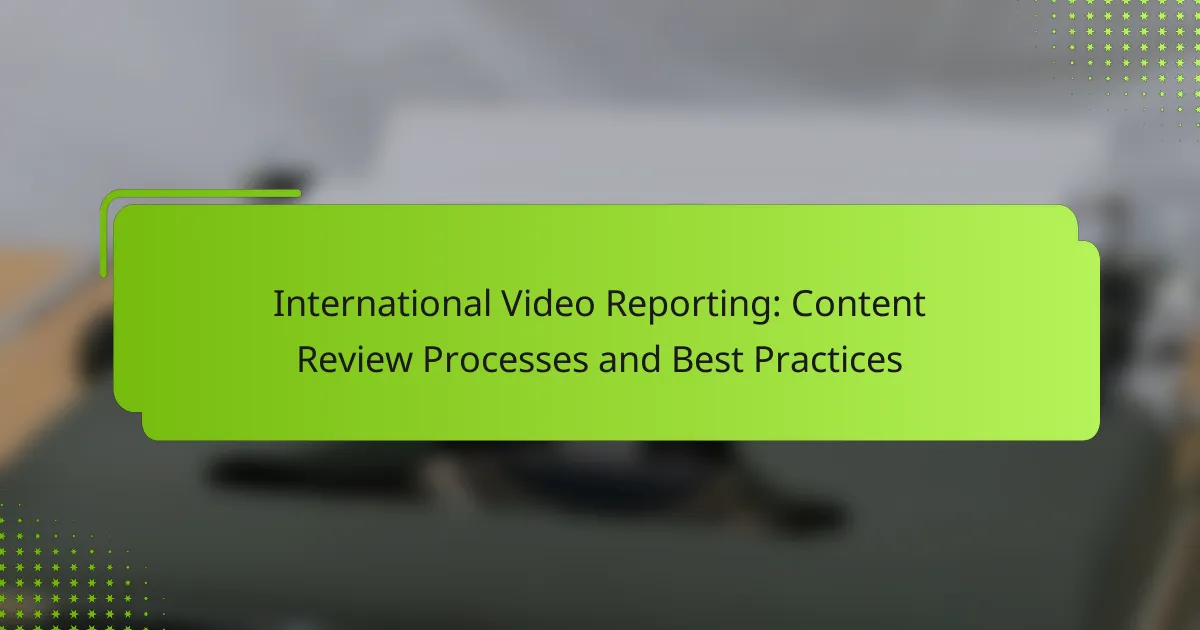International video reporting demands strict adherence to ethical standards that prioritize integrity, respect, and responsibility. Journalists must ensure accuracy while safeguarding the rights and dignity of individuals featured in their stories, which involves thorough research and cultural sensitivity. By following guidelines for sourcing and licensing video content, reporters can uphold these ethical principles and honor the contributions of original creators.
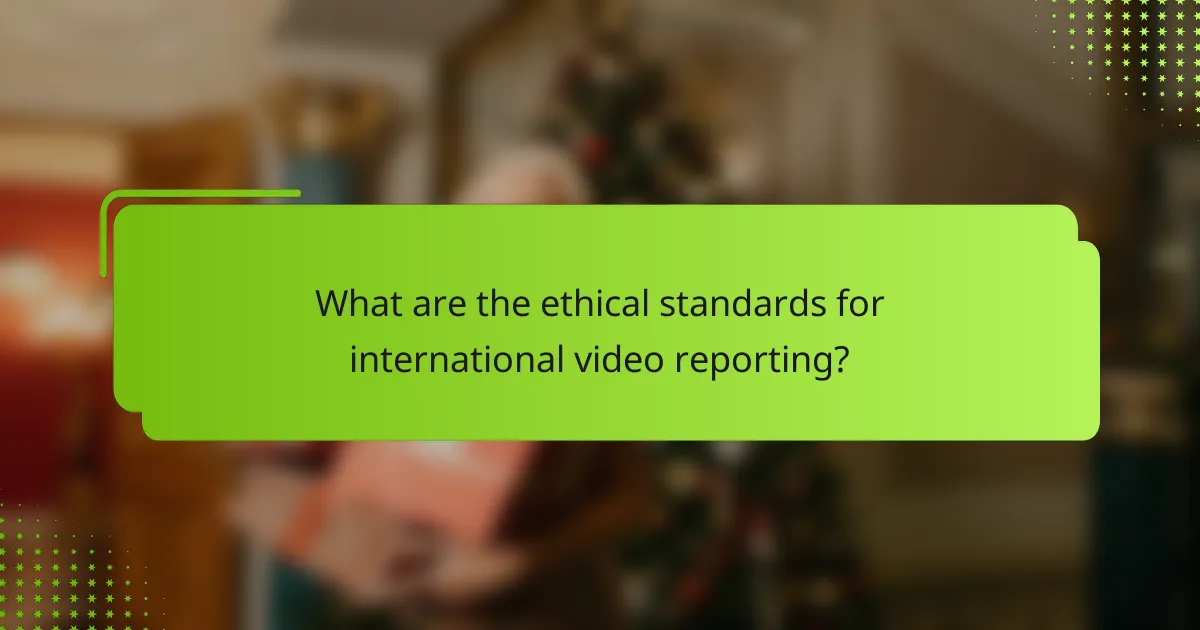
What are the ethical standards for international video reporting?
Ethical standards for international video reporting focus on integrity, respect, and responsibility. These guidelines ensure that journalists provide accurate information while protecting the rights and dignity of individuals involved in their stories.
Accuracy and truthfulness
Accuracy and truthfulness are paramount in international video reporting. Journalists must verify facts and present information without distortion, ensuring that the audience receives a clear and honest depiction of events. This often involves cross-checking sources and corroborating details before publication.
For example, when reporting on a conflict, it is essential to confirm the identities of individuals and the context of their actions. Misrepresentation can lead to misinformation and damage reputations, so maintaining a commitment to truth is crucial.
Respect for privacy
Respect for privacy is a critical ethical standard in video reporting, particularly in sensitive situations. Journalists should consider the implications of their work on the individuals featured in their reports, especially in vulnerable populations. Obtaining consent before filming is a best practice that helps safeguard personal privacy.
In instances where individuals may be at risk, such as whistleblowers or victims of violence, it is vital to anonymize their identities or use blurred images to protect them. This approach not only upholds ethical standards but also fosters trust between journalists and the communities they report on.
Minimizing harm
Minimizing harm involves a careful assessment of the potential impact of video reporting on individuals and communities. Journalists should strive to avoid sensationalism and respect the dignity of those involved in their stories. This means being mindful of how graphic content is presented and the emotional toll it may take on viewers and subjects alike.
For instance, when covering natural disasters, reporters should focus on the resilience and recovery efforts of affected communities rather than solely on the devastation. This approach can help promote a more constructive narrative and reduce the potential for further trauma.
Transparency and accountability
Transparency and accountability are essential for maintaining public trust in international video reporting. Journalists should disclose their sources and methods whenever possible, allowing audiences to understand how information was gathered. This openness fosters credibility and encourages ethical practices within the industry.
Additionally, media organizations should have clear policies for addressing errors and correcting misinformation. Establishing a culture of accountability helps ensure that journalists take responsibility for their work and remain committed to ethical reporting standards.
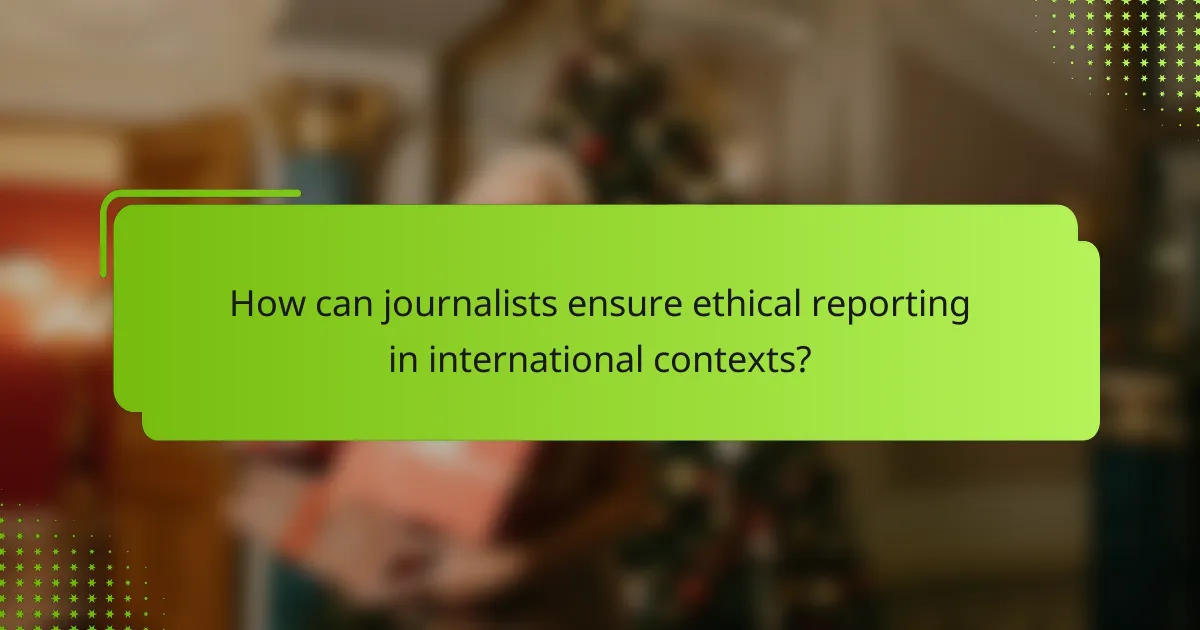
How can journalists ensure ethical reporting in international contexts?
Journalists can ensure ethical reporting in international contexts by prioritizing accuracy, respect for local cultures, and adherence to legal frameworks. This involves thorough research, community engagement, and a deep understanding of local laws and customs.
Conduct thorough research
Thorough research is essential for ethical reporting, especially in international contexts. Journalists should verify facts from multiple credible sources and understand the historical and cultural background of the region they are covering.
Utilizing local news outlets, academic publications, and expert interviews can provide valuable insights. This approach helps avoid misrepresentation and ensures a more nuanced portrayal of events.
Engage with local communities
Engaging with local communities fosters trust and enhances the quality of reporting. Journalists should seek to build relationships with community members, listening to their perspectives and experiences.
Participating in community events or forums can provide journalists with a deeper understanding of local issues. This engagement helps ensure that the voices of those affected by the news are heard and accurately represented.
Adhere to local laws and customs
Adhering to local laws and customs is crucial for ethical international reporting. Journalists must familiarize themselves with the legal landscape of the country they are reporting from, including regulations regarding privacy, defamation, and media operations.
Respecting local customs, such as cultural sensitivities and social norms, is equally important. This respect not only protects journalists from legal repercussions but also fosters goodwill and cooperation with local communities.

What guidelines should be followed for sourcing video content?
When sourcing video content, it is essential to adhere to guidelines that ensure authenticity, proper crediting, and licensing. These practices help maintain ethical standards in international video reporting and protect the rights of original creators.
Verify authenticity
Verifying the authenticity of video content is crucial to prevent the spread of misinformation. Check the source of the video, look for metadata, and cross-reference with reputable news outlets. Tools like reverse image search can help confirm the origin of the footage.
Consider the context in which the video was recorded. Understanding the location, date, and circumstances can provide insights into its credibility. Always be cautious of edited or manipulated videos that may misrepresent the truth.
Credit original creators
Giving credit to original creators is a fundamental ethical practice in video reporting. Always attribute the source of the footage, including the name of the creator and the platform where it was published. This not only respects the rights of the creator but also enhances transparency for your audience.
In some cases, you may need to seek permission from the creator before using their work. This can involve formal agreements or simply reaching out via email or social media. Respecting intellectual property fosters a culture of collaboration and trust within the media community.
Use licensed footage
Using licensed footage is essential to avoid legal issues and respect copyright laws. Always ensure that the video content you are using is properly licensed for your intended use, whether it be for commercial or educational purposes. Licensing agreements typically outline how the footage can be used and any associated fees.
Consider using stock video platforms that offer a wide range of licensed footage. Many of these platforms provide clear licensing terms, making it easier to find content that fits your needs without infringing on copyright. Always read the licensing agreements carefully to understand your rights and obligations.

What role do organizations play in establishing video reporting ethics?
Organizations play a crucial role in establishing ethical standards for video reporting by providing guidelines that promote integrity, accuracy, and accountability. These frameworks help journalists navigate complex situations, ensuring that their reporting respects the rights and dignity of individuals while maintaining public trust.
International Federation of Journalists (IFJ) guidelines
The International Federation of Journalists (IFJ) provides a comprehensive set of guidelines aimed at fostering ethical video reporting practices. These guidelines emphasize the importance of truthfulness, fairness, and respect for privacy, urging journalists to verify information before publication and to avoid sensationalism.
Key principles include obtaining informed consent from subjects, particularly in sensitive situations, and ensuring that the portrayal of individuals does not exploit their circumstances. Journalists are encouraged to reflect on the potential impact of their work on the lives of those featured in their reports.
Committee to Protect Journalists (CPJ) standards
The Committee to Protect Journalists (CPJ) sets forth standards that focus on the safety and rights of journalists, as well as the ethical considerations in video reporting. Their guidelines stress the need for journalists to protect their sources and to report without fear of retribution, which is essential for maintaining journalistic integrity.
Additionally, CPJ encourages journalists to be transparent about their methods and to disclose any potential conflicts of interest. This transparency helps build credibility and trust with the audience, which is vital in an era of misinformation.
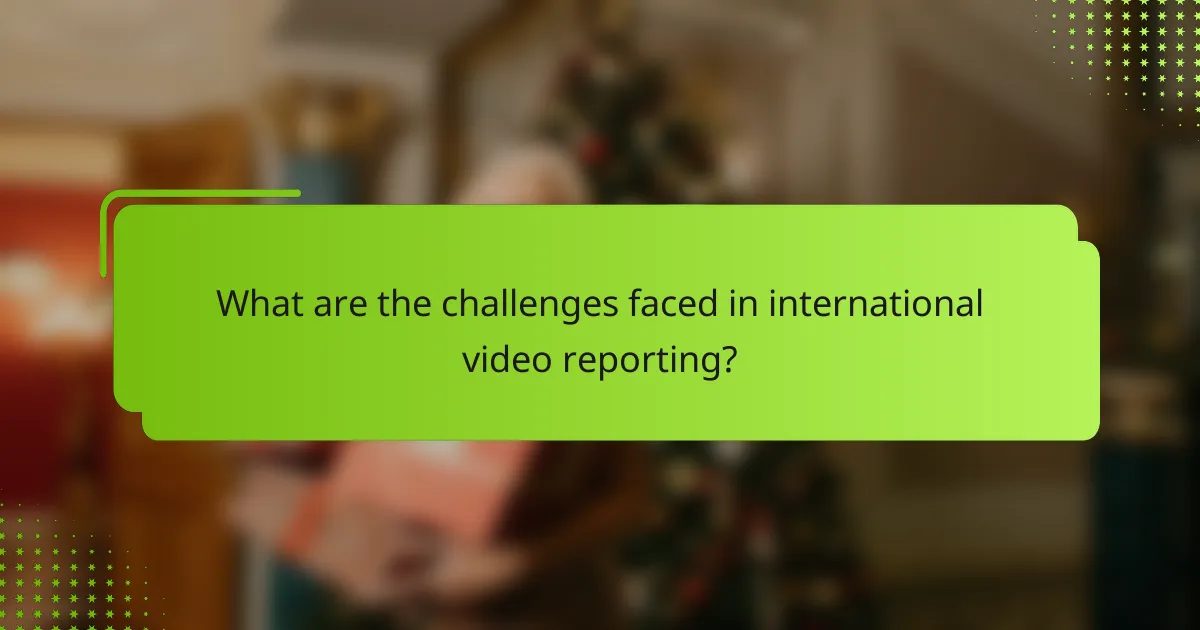
What are the challenges faced in international video reporting?
International video reporting presents several challenges, including censorship, journalist safety, and access to reliable information. These factors can significantly impact the quality and integrity of news coverage across borders.
Censorship and government restrictions
Censorship and government restrictions are prevalent issues in international video reporting. Many countries impose strict regulations on media content, limiting what can be reported or broadcasted. Journalists often face legal repercussions for covering sensitive topics, which can lead to self-censorship.
For example, in some authoritarian regimes, any critical coverage of the government may result in fines or imprisonment. Reporters must navigate these restrictions carefully, often relying on local contacts and anonymous sources to gather information without facing backlash.
Safety of journalists
The safety of journalists is a critical concern in international video reporting. Journalists often work in conflict zones or politically unstable regions, exposing them to threats such as violence, kidnapping, or harassment. According to various reports, the number of journalists killed while covering stories in dangerous areas has been alarmingly high.
To mitigate risks, journalists should prioritize safety training and develop emergency plans. Utilizing protective gear and establishing secure communication channels can also help ensure their safety while reporting in hostile environments.
Access to reliable information
Access to reliable information is essential for accurate international video reporting. However, journalists often struggle to verify facts due to misinformation, propaganda, or limited access to sources. This challenge is exacerbated in regions with restricted internet access or where media outlets are controlled by the state.
To enhance credibility, journalists should cross-check information from multiple sources and utilize fact-checking tools. Building a network of trusted local informants can also provide valuable insights and help confirm the accuracy of reported information.

How can technology enhance ethical video reporting?
Technology can significantly enhance ethical video reporting by providing tools that improve accuracy, transparency, and accountability. Innovations such as drones, mobile reporting apps, and advanced editing software enable journalists to capture and present information more responsibly and effectively.
Use of drones for aerial footage
Drones offer a unique perspective for video reporting, allowing journalists to capture aerial footage that is often difficult or impossible to obtain otherwise. They can provide context to stories, such as visualizing the scale of a disaster or the layout of a protest, which enhances audience understanding.
When using drones, it is crucial to adhere to local regulations regarding airspace and privacy. For example, in many countries, operators must obtain permits and ensure they do not invade individuals’ privacy. Ethical considerations include obtaining consent when filming private property and being mindful of the potential impact on communities.
To maximize the benefits of drone footage, journalists should plan their shots carefully and consider the narrative they wish to convey. Using drones responsibly can enhance storytelling while maintaining ethical standards, ensuring that the footage serves the public interest without compromising individuals’ rights.
